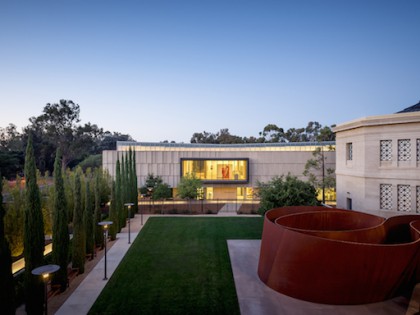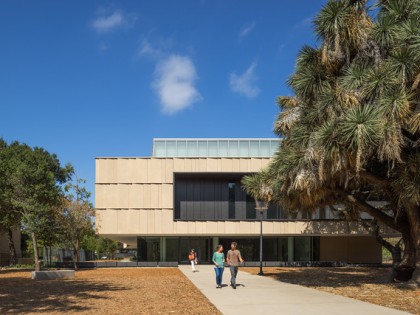The Stanford Arts District fell out of a private jet crossing the country in 2007, on a return flight from a celebration of the program Stanford in Washington. The plane was chartered by Burt McMurtry, a member of the Stanford University Board of Trustees, and it carried two other passengers: McMurtry’s wife, Deedee, and Stanford President John Hennessy. Hennessy sat in back working at his laptop until the moment he moved forward to the seat opposite McMurtry. “Middle of the country somewhere,” is how McMurtry recalls it. “He said, ‘I really want to get this consolidation of art and art history near Cantor. Would you guys do a lead gift for it?’ ” Hennessy returned to his seat while “we thought about it for about five minutes and said ‘sure,’ ” McMurtry says. And how much was that handshake deal worth? “Thirty million.” The McMurtrys had developed an interest in art while they were undergraduates at Rice University in Houston, and it escalated when they came west in 1957. He took a job at Sylvania and enrolled in a part-time program to work toward a graduate degree in electrical engineering at Stanford. Once he had his doctorate in 1962 and was working full time, “my wife and I would go to the art fairs at Foothill College and buy a little tiny thing,” he says. “One thing led to another.” Engineering led to venture capital. Art fair posters have led to an apartment stuffed with the likes of Richard Diebenkorn and Wayne Thiebaud in a luxury retirement community on Stanford land. Burt McMurtry joined the board of trustees in 1997, and after fellow engineer John Hennessy was named president, in 2000, they devised a strategy for turning Cantor into “a major museum destination,” McMurtry says. Rather than build its reputation by competing with other museums for art coming to market, Stanford decided to end-run the piecemeal approach by acquiring an entire collection. They looked around, and the obvious choice was the collection of postwar American art amassed by Harry W. “Hunk” and Mary Margaret “Moo” Anderson. “We decided the Anderson collection was something we should try very, very hard to get,” McMurtry says, “so I decided to call Hunk, who I barely knew, in June of 2004.” That conversation was still going in 2008 when the announcement was made of the lead donors to the McMurtry Building for the Art and Art History. “It helped in dealing with the Andersons,” McMurtry says. “They got to see a lot of real action.” In 2011, Hunk and Moo Anderson, along with their daughter “Putter” Anderson Pence, gifted 121 works by 86 artists to Stanford, which none of the Andersons attended. The works range from the drip art of Jackson Pollock to the candy counters of Thiebaud, and is worth more than $200 million on the open market, according to one estimate. University funds and private donations covered the $30 million cost of the two-story building to house it. The same funding mechanism is covering the majority of the cost for the McMurtry Building. These new buildings will flank the Cantor Arts Center and form a triangle off in a corner of campus where sleek modernist architecture and shiny siding won’t clash with the Romanesque sandstone of the Main Quad. Designed by Ennead Architects, in the ranch-house style of the Anderson home in Atherton, the Anderson Collection is its own entity with its own director and team of curators, separate from Cantor. The McMurtry Building, at 96,000 square feet on four levels, will be three times the size of Anderson and cost more than twice as much, $85 million. The design is angular and sleek, with a wraparound zinc skin. It won’t open until fall of 2015, but it will be completed a year from now, and McMurtry is pushing the schedule. “I’ve got a request in to the land and buildings people that it would be really neat to finish the construction of the building on March 26, 2015,” he says – “my 80th birthday.”
Welcome to the Anderson Collection
Stanford University's free museum of modern and contemporary American art







